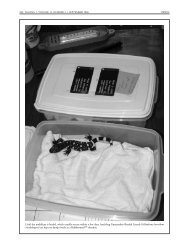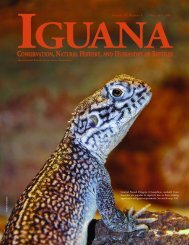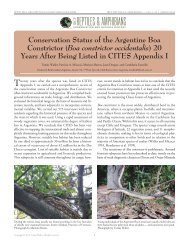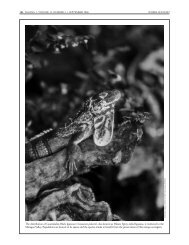Spiny-tailed Iguanas (Ctenosaura similis) in Venezuela
Spiny-tailed Iguanas (Ctenosaura similis) in Venezuela
Spiny-tailed Iguanas (Ctenosaura similis) in Venezuela
Create successful ePaper yourself
Turn your PDF publications into a flip-book with our unique Google optimized e-Paper software.
THERESA CROW, MISSOURI STATE UNIVERSITY<br />
CONSERVATION RESEARCH REPORTS<br />
Non-native Fishes Threaten<strong>in</strong>g<br />
Hellbenders <strong>in</strong> Missouri<br />
The <strong>in</strong>troduction of non-native fishes<br />
often results <strong>in</strong> the local ext<strong>in</strong>ction of<br />
native amphibians due to a lack of evolutionary<br />
history and resultant m<strong>in</strong>imallyadapted<br />
antipredator behaviors toward<br />
the <strong>in</strong>troduced fishes. Populations of<br />
Hellbenders (Cryptobranchus alleganiensis)<br />
<strong>in</strong> Missouri have decl<strong>in</strong>ed considerably<br />
s<strong>in</strong>ce the 1980s, co<strong>in</strong>cid<strong>in</strong>g with a<br />
rapid <strong>in</strong>crease <strong>in</strong> non-native trout <strong>in</strong>troductions<br />
for recreational angl<strong>in</strong>g. GALL<br />
(2008. Unpubl. M.S. Thesis, Missouri<br />
State University, Spr<strong>in</strong>gfield) exam<strong>in</strong>ed<br />
Hellbender and fish predator-prey <strong>in</strong>teractions<br />
by: (1) exam<strong>in</strong><strong>in</strong>g the forag<strong>in</strong>g<br />
behavior of predatory fishes <strong>in</strong> response<br />
to a Hellbender secretion; (2) compar<strong>in</strong>g<br />
the number of secretion and controlsoaked<br />
food pellets consumed by trout;<br />
and (3) compar<strong>in</strong>g the response of larval<br />
Hellbenders to chemical stimuli from<br />
<strong>in</strong>troduced (trout) and native fish predators.<br />
Brown Trout, Walleye, and large<br />
Banded Sculp<strong>in</strong>s responded to<br />
Hellbender secretions with <strong>in</strong>creased<br />
activity, whereas small Banded Sculp<strong>in</strong>s<br />
responded by decreas<strong>in</strong>g activity. In addition,<br />
Brown Trout <strong>in</strong>gested more<br />
Hellbender secretion-soaked food pellets<br />
than control pellets, whereas Ra<strong>in</strong>bow<br />
Trout expelled secretion-soaked food pellets.<br />
F<strong>in</strong>ally, larval Hellbenders exhibited<br />
weak fright behavior <strong>in</strong> response to<br />
chemical stimuli from nonnative trout<br />
relative to their responses to native predatory<br />
fish stimuli. These comb<strong>in</strong>ations of<br />
responses <strong>in</strong>dicate that predation by non-<br />
native fishes may be a plausible hypothesis<br />
for the decl<strong>in</strong>e of Hellbender populations<br />
<strong>in</strong> Missouri.<br />
Effects of Convert<strong>in</strong>g Dry Tropical<br />
Forest to Agricultural Mosaics<br />
SUAZO-ORTUÑO ET AL. (2008. Conservation<br />
Biology 22: 362–374) explored the<br />
impact of forest conversion to agricultural<br />
mosaic on anuran, lizard, snake,<br />
and turtle assemblages <strong>in</strong> Neotropical dry<br />
forests. Over two years, the authors sampled<br />
six small watersheds on the western<br />
coast of Mexico, three conserved and<br />
three disturbed. The disturbed watersheds<br />
were characterized by a mosaic of<br />
pastures and cultivated fields (corn,<br />
beans, squash) <strong>in</strong>term<strong>in</strong>gled with patches<br />
of different successional stages of dry forest.<br />
In each watershed, they conducted<br />
11 diurnal and nocturnal time-constra<strong>in</strong>ed<br />
searches <strong>in</strong> ten randomly established<br />
plots. We considered vulnerability<br />
traits of species <strong>in</strong> relation to habitat<br />
modification. Eighteen anuran, 18 lizard,<br />
23 snake, and three turtle species were<br />
recorded. Thirty-six species (58%)<br />
occurred <strong>in</strong> both forest conditions, and<br />
14 (22%) and 12 species (19%) occurred<br />
only <strong>in</strong> the conserved and disturbed sites,<br />
respectively. Assemblages responded differently<br />
to disturbance. Species richness,<br />
diversity, and abundance of lizards were<br />
higher <strong>in</strong> disturbed forests. Anuran diversity<br />
and species richness were lower <strong>in</strong><br />
disturbed forest, but abundance was sim-<br />
IGUANA • VOLUME 15, NUMBER 3 • SEPTEMBER 2008 177<br />
CONSERVATION RESEARCH REPORTS<br />
Populations of Hellbenders (Cryptobranchus<br />
alleganiensis) <strong>in</strong> Missouri have decl<strong>in</strong>ed considerably<br />
s<strong>in</strong>ce the 1980s, co<strong>in</strong>cid<strong>in</strong>g with a<br />
rapid <strong>in</strong>crease <strong>in</strong> non-native trout <strong>in</strong>troductions<br />
for recreational angl<strong>in</strong>g.<br />
Ameiva undulata (illustrated) and Sceloporus utiformis were the only two sampled species of<br />
lizards that were disturbance-sensitive. Both are terrestrial and forage <strong>in</strong> the leaf litter. Reduction<br />
of the litter may be responsible for the decl<strong>in</strong>e of these species <strong>in</strong> disturbed forests.<br />
ilar <strong>in</strong> both forest conditions. Diversity,<br />
richness, and abundance of turtles were<br />
lower <strong>in</strong> disturbed forest. The structure<br />
and composition of snake assemblages<br />
did not differ between forest conditions.<br />
Species were considered disturbance-sensitive<br />
if their abundance was significantly<br />
less <strong>in</strong> disturbed areas. Four anuran<br />
(22%), two lizard (11%), and three turtle<br />
(100%) species were sensitive to disturbance.<br />
No snake species was sensitive.<br />
The decl<strong>in</strong>e <strong>in</strong> abundance of disturbance-sensitive<br />
species was associated<br />
with the reduction of forest canopy cover,<br />
woody stem cover, roots, and litter-layer<br />
ground cover. Anuran species with small<br />
body size and direct embryonic development<br />
were especially sensitive to forest<br />
disturbance. An important goal for the<br />
conservation of herpetofauna should be<br />
the determ<strong>in</strong>ation of species traits associated<br />
with ext<strong>in</strong>ction or persistence <strong>in</strong><br />
agricultural mosaics.<br />
Reptilian Road Mortality<br />
<strong>in</strong> Ill<strong>in</strong>ois<br />
Roads have numerous negative ecological<br />
effects on terrestrial fauna, and vehicular<br />
mortality can have significant demographic<br />
consequences for some species.<br />
SHEPARD ET AL. (2008. Copeia 2008:<br />
350–359) studied road mortality of reptiles<br />
around Carlyle Lake, Cl<strong>in</strong>ton<br />
County, Ill<strong>in</strong>ois, USA, from April 2000<br />
through November 2002, to assess the<br />
impact of vehicular traffic and identify<br />
ROBERT POWELL








